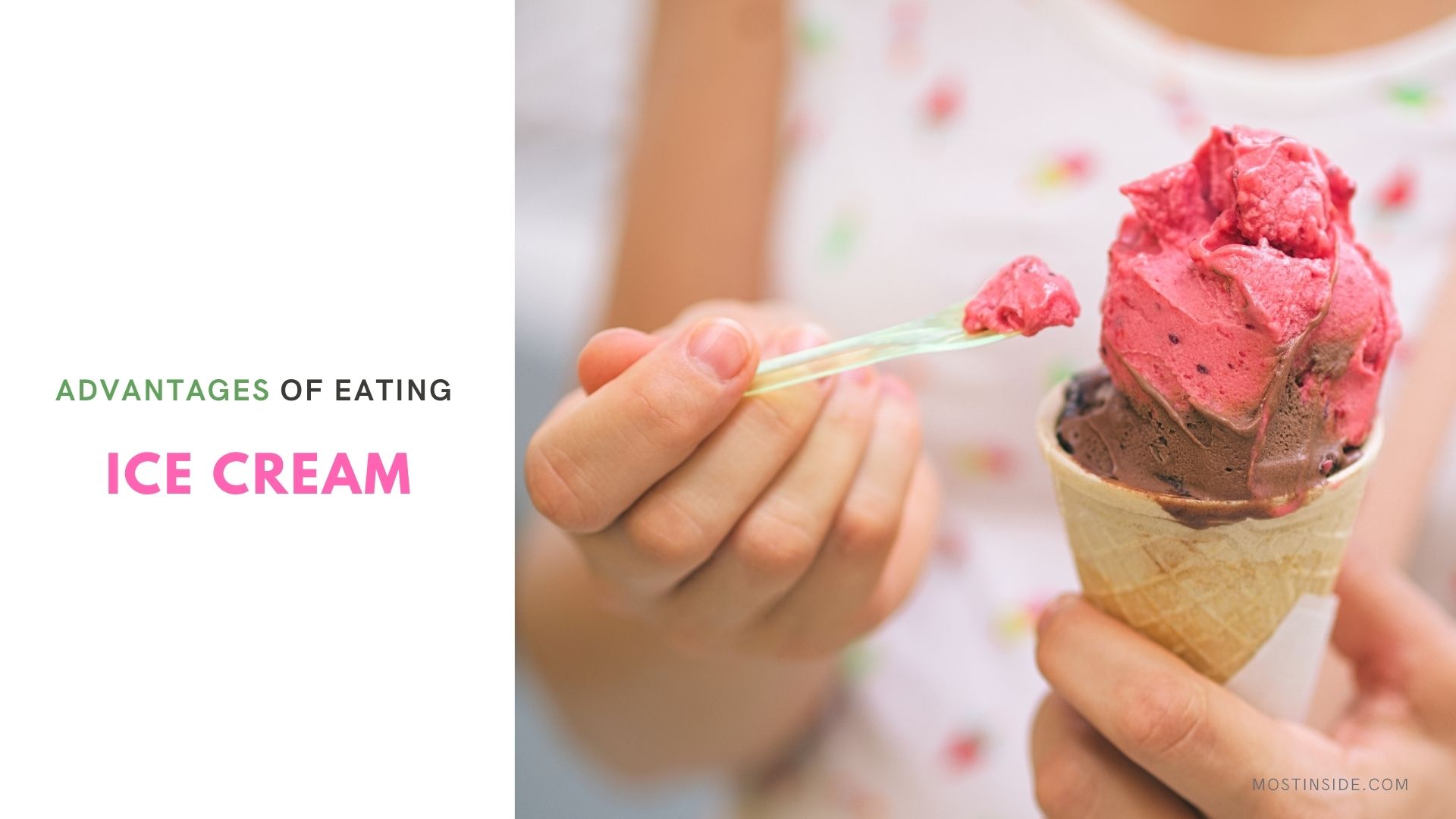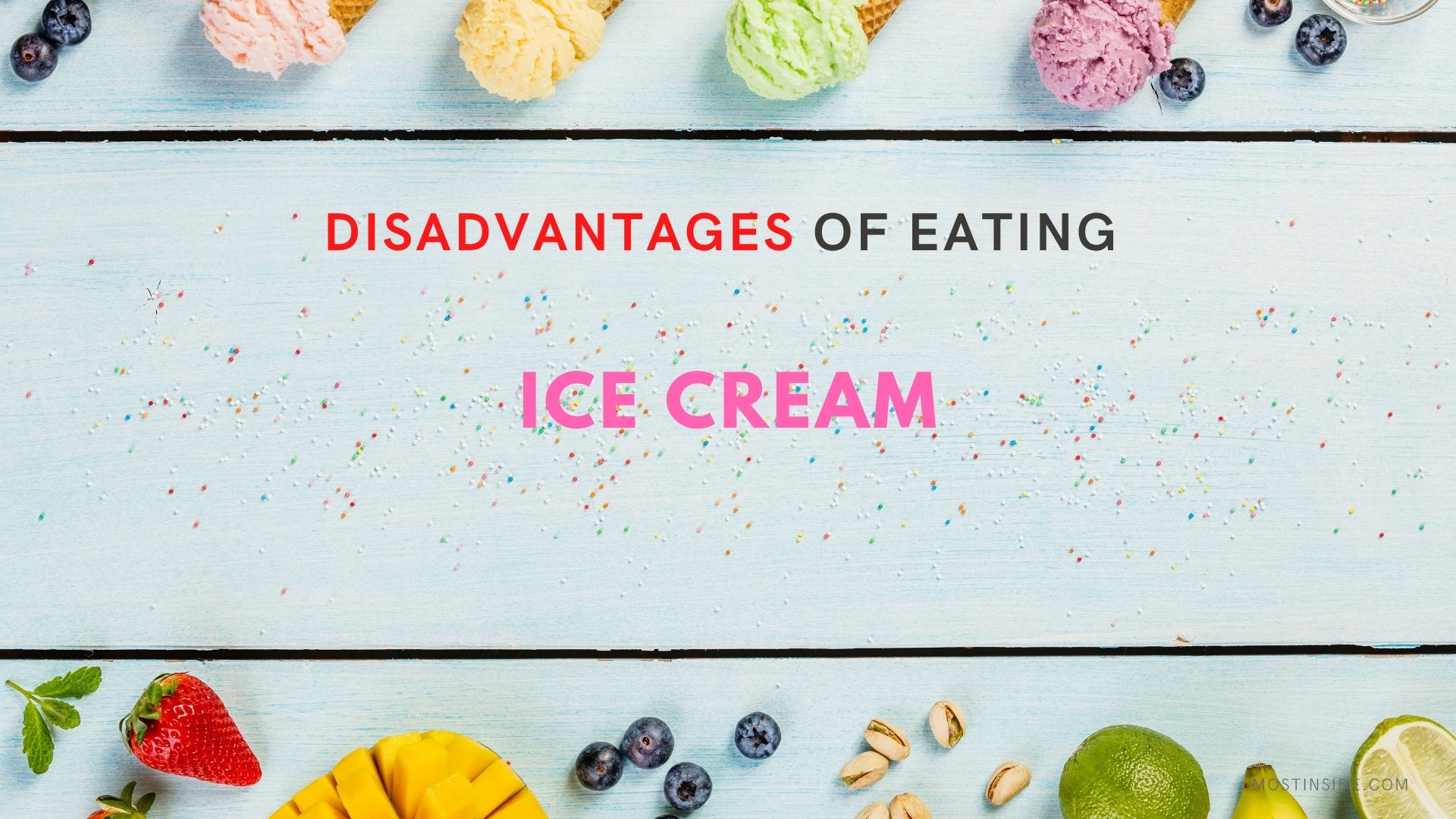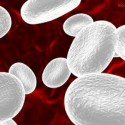Know These Advantages And Disadvantages of Eating Ice Cream

Ice Cream takes you to a yummy scoop of different flavours such as vanilla, tutti-fruiti, butterscotch, blue moon, and chocolate with all the trimmings on a scorching summer day and some prefer it on cold winter, or rainy days regardless of seasons. This is perhaps due to its melting and mouth-watering taste. Most people understand that ice cream is fattening, however this frozen delight has a few health advantages also. Though in life, excessive goodness of something also has its downsides.
A favourite sweet dish for kids and all age groups during the summer season, ice cream is composed of milk normally and features as a hard to resist attraction in marriage ceremony, get together, and birthday parties.
However, consuming ice cream has some benefits and drawbacks though it is the preferred dessert of all.

Here are some of the advantages of consuming your favourite ice cream:
Contents
Toggle#1 A Perfect Source Of Energy
Although the nutritional content of ice cream differs among brands and types, it is a superb source of energy. Ice cream is full of carbohydrate, carrying nearly 15 grams in a one-half-cup serving. A serving also includes nearly 7 grams of fat and 2 grams of protein, making it an energy-dense food. As per the U.S. Department of Agriculture, a half cup of vanilla ice cream generates 137 kilocalories of energy, almost double the amount present in one-half cup of whole milk. Ice cream is an excellent choice when you require energy or if you are following a schedule to put on weight.
#2 A Powerful Source Of Minerals
Ice cream is also a dietary source of two vital minerals. It is especially abundant in calcium and phosphorus, with almost 10% of the adult recommended dietary allowance, or RDA, of these minerals within a single, one-half-cup serving. Both calcium and phosphorus promote strong, healthy bones. In reality, consuming a lot of calcium, but not phosphorus, wouldn’t be too good for your bones. While substantial amounts of these nutrients don’t constitute ice cream a health food, you can regard them a modest goody when you do indulge.
Packed with calcium and phosphorus, eating ice cream can be helpful for making bones and teeth strong while supporting healthy cardiovascular system and kidney functions. Medical studies have mentioned that for calcium assimilation in the body, consumption of foods containing phosphorus is very essential. As ice cream contain phosphorus also, your joints stay healthy and it prevents PMS (Premenstrual Syndrome).
#3 Loaded With Vitamins
Ice cream is filled with vital nutrients. Actually, this frozen dessert is stacked with vitamin B6, A, B12, D, C, and E. Ice cream is also replete with vitamin K. Vitamin K is an essential nutrient that thins out the blood and avoids blood clotting. Besides vitamins, ice cream is also abundant in thiamine, niacin, antioxidants, and riboflavin which can also aid in stopping cancer causing free radical effects from the body. These nutrients fortify the immune system, besides improving organ and nerve functions.

#4 Successfully Handles Mood Swings
A compound in ice cream is believed to stimulate the production of thrombotonin, a hormone that elevates mood and aids in preventing mood swings. Eating ice cream also reduces cortisol levels, thus lowering stress. Moreover, as milk includes L-tryptophan which is a natural sedative, your nervous system will become relaxed and this avoids insomnia. So the next time you hit low or feel stressed, snatch your favourite bowl of ice cream and you will experience complete bliss.

Let’s take a look at some of the disadvantages of eating ice cream which includes the following:
#1 Filled With Fat
Commonly made from whole fat milk, ice cream are abundant in saturated fats. Though the fat in ice cream offers instant energy, secures the organs from adverse impacts of stress, and activates the production of different types of enzymes, the saturated fats can be a prime determinant for cardiovascular ailments and obesity. All these can contribute to multiple lifestyle diseases. You can opt for having ice cream occasionally or consume small cups of low fat ice cream that can be obtained easily from the markets.
#2 Heavy Cholesterol Content
Among the major drawbacks of eating ice cream on wellness is that it includes high levels of bad cholesterol. It has been researched that just half a cup of vanilla ice cream consists of 25 mg of cholesterol and consuming this frozen dessert frequently can place your heart’s health at huge risk.
#3 Too Much Sugar
Ice cream carries huge amounts of sugar which can cause weight gain, cardiovascular ailments, diabetes and various lifestyle diseases. Simply one serving of vanilla ice cream carries 40 calories from sugar, which constitutes 40% of the overall quantity of sugar advised by the American Heart Association to be consumed daily.

#4 Difficult To Digest
Medical researchers have discovered that ice cream is composed of hard to digest dairy and it becomes even harder to digest due to its frozen state. Ayurveda has elucidated that anything cold when added to the digestive system, extinguishes the digestive fire, which is very essential for efficient digestive functioning and absorption of nutrients. That is why Ayurveda mentions that eating frozen desserts can cause digestive disorders.
#5 Unsuitable For Lactose Intolerant
According to a study performed by a famous tabloid, nearly 30 million Americans are intolerant to lactose. Ice cream is a dairy based product and is filled with lactose, a milk sugar which can be split down and digested solely through the availability of lactase enzyme in the stomach. Absence of this enzyme can cause severe digestive problems and so, persons who are intolerant to lactose should avoid consuming ice cream.
As ice cream includes dairy milk sugar (lactose), lactose-intolerant persons may acquire indigestion, excess flatulence, abdominal cramps, and diarrhea, to name a few. Moreover, nuts or additives contained in the ice cream may activate allergic reaction in susceptible persons. Consumption of improperly prepared or handled ice cream and/or contaminants can result in bacterial food poisoning. Popular microorganisms are Yersinia enterocolitica, Bacillus cerus, Salmonella enteritidis, E.coli, and Staphylococcus.
A study conducted by Ismail N et al at University Kebangsaa in Malaysia says that excessive consumption of dairy products, including ice cream, mixed with other factors, like a person’s family history, have been associated to the growth of pimples (acne vulgaris) in a few individuals. Consuming ice cream can lead to headaches, especially in individuals having a history of migraine headaches, on account of irritation of branches of the trigeminal nerves lodged in the mouth cavity. This normally happens when ice cream is eaten in a hasty manner, particularly in hot weather.
Inferior quality ice creams may also include unhealthy or even toxic chemicals as ingredients or fillers, although they are ‘generally recognized as safe’ by the FDA. Such chemicals include artificial colorants, artificial sweeteners, artificial flavourings (such as vanilla), polysorbate 80 (employed in cosmetics), preservatives, ethyl acetate (utilized as cleansing agent for textiles), diethyl glycol (used as anti-freeze), and gum. Furthermore, increasing number of artificial substances is largely replacing natural ingredients available in the conventional ice cream. To worsen matters, the FDA does not need the product manufacturers to list all of their ingredients on the pack. So, consumers may not be completely aware of the possible harmful components they may be ingesting through ice cream.
Conclusion
To sum up, ice cream has its drawbacks, since it is high in calories with elevated saturated fat and cholesterol content. Ice cream may also include lactose, harmful additives and chemicals, besides specific allergens like nuts. A correct awareness of the ingredients on labels when selecting ice cream and consumption within limits is the key to reducing the potential harmful effects of ice cream, even while acclimatizing your taste buds to this invigorating, cool delight.
Recommended: Best Brands of Ice Cream in India
Recommended For You
Phenocal Review: Does It Really Work for Weight-Loss?
Sujata Sanyal
Sujata Sanyal has been in the writing circuit for the past 7 years and has touched upon various genres like travel, health, lifestyle, a wee bit of technology, cuisine, product descriptions and a bevy of others. 1 part of her is interested in animated political discussions, 2nd part interested in studying biographies and the remainder part in love with music and socially relevant work. Too many parts?




